The Fabric of Canada- Juniper Publishers
Archaeology & Anthropology- Juniper Publishers
Of Making Cloth with Sheeps Wool Smallest and smoothest pile grow on the pole. The coarsest about the Tayle. The shortest on ye head and on some parts of ye belly. The longest on ye flanks. Being sorted to wash it in ordinary water, in soape, then its dyed in rase otherwise it is wrought while into cloth and the cloth dyed afterwards [1].
The textile industry changed in the 17th century from
one which depended on the domestic “cottage industry” for supplies to
one which became reliant on mass-production and a cosmopolitan trade
network in which North America became a consumer [2]. The rise of the
warehouseman and the factory meant that the small markets and halls used
when goods were produced in homes by families were abandoned for inns
and warehouses [3]. The introduction of the New Draperies, which were
manufactured with different looms, used worsted yarns, which produced
finer fabric, with a higher thread count [4]. The quotation above
reflects upon the domestic clothing industry of the 1660s in England,
which, with the introduction of the New Draperies and ready-mades, would
by the 18th century be forever changed [5]. Clothing would become more
disposable as cheaper methods for weaving, knitting, dyeing and
constructing would become available. Because a society’s costume helps
to define groups by country, region and status, changes in its
production impacted society in other ways. As a consumable, this
commodity, in terms of wool production, was England’s major export from
the Medieval period through to early modern period [6]. This commodity
afforded England the financial capability to explore other geographic
regions and allowed it to become one of the largest Empires of the
Modern Period. The fabric of a nation, however, is not based solely on
its economic wealth. Once the fibre is woven into cloth, dyed, and
constructed into a garment, it becomes an item which can define a region
and status. Personal items such as costume are adapted to fit
the needs of smaller groups, such as colonizing peoples, within a
nation.
The textile industry and costume construction and
style influenced 17th -century society, from being a major industry to
contributing to the stratification of social structure and the notion
that the “clothes make the man”. We can therefore garner information
about the past by examining archaeological textile remains, extant
textiles, and textile images portrayed in printed images.
Many questions arise from the research previously
described. The examination of the Ferryland textile collection has aided
understanding of English colonial life in the 17th century. This has
been made possible by employing a variety of techniques including the
archaeological and analytical sciences, the results of which have been
described in previous chapters. The following discussion will combine
information gleaned from this analysis. The importance of the small
finds excavated from an undisturbed 17th -century privy has shed light
on the many changes that occurred in this period on the north eastern
American continent.
The Ferryland Collection
The bulk of the textile remains that comprise the
Ferryland textile assemblage were excavated from a privy, in use from
the 1621, to the early 1670s, when it was capped following the Dutch
raid in 1673. Hundreds of square fragments of cloth excavated from the
privy, were used for hygiene purposes, but by whom? The scraps of silk
trim were likely scraps from a tailor, possibly William Sharpus or a
second tailor who replaced him, but from which household? Captain Wynne
arrived in Ferryland in 1621 with a dozen settlers [7]. Twenty more
settlers arrived in 1622 including a tailor, a surgeon, blacksmiths,
fishermen,
boat masters, a husbandman, a quarryman, women, children and
servants [8].
At this point there is mention of a kitchen, a parlour, a
henhouse, defensive works, two tenements, salt works and
a forge having been built, and with a brew house under
construction [9]. Calvert visited the colony in 1627 and in 1628
he brought his family and an additional 40 settlers to Ferryland.
The following year he quit the colony, moved his family back to
England and went south to explore the Chesapeake area [10].
The Kirke’s arrived in Ferryland in 1638 bringing some 100
settlers. They continued to build (for example the Kirke houses
at Area F), and profit from the rich fishery [11]. Captain Wynne,
who directed the initial building phase including the warehouse,
seawall and privy of Area C, made his buildings to last, which is
in part why they exist today. Although not directly referenced to
in any of Wynne’s letters, one of his letters dated 1621, alludes to
the construction of the “Harbour” [12]. This reference indicates
that the privy, which was part of the seawall construction, may
have been available for use as early as 1621. Wynne may well
have been one of the first to use the privy. As Governor of this
colony (and an employee of the East India Company) he could
likely have afforded the luxury of clouts for the privy.
To date, the Mansion House, Calvert’s residence, has not
been found. No privy is mentioned in Wynne’s descriptions of
the Mansion House. We think, therefore, that Calvert also likely
made use of the privy. Chamber pots, though available at the
time, have not been found in any quantity among the ceramic
remains at Ferryland. It is therefore possible that all of the
gentry used the waterfront privy. Given its public location, it is
possible that was used by gentry-class men who did business
with incoming and outgoing ships. It may also have been used by
gentle women, such as Lady Kirke, who, with the help of her sons,
ran her husband’s business from 1651 until her death sometime
in the 1670s [13]. One thing that is certain is that this privy was
associated with a work area, rather than a domestic structure.
The privy was therefore likely used by all involved in the fishery
from those who fished, to those who sold the final product. In
terms of the textile remains left in the privy, the difference may
have been between those of a gentry sort had clouts to use and
the fishermen who did not. This could explain the high-quality
wool fragments used for hygiene purposes. The tailor’s scraps of
silk cloth and trim, unsuited to hygiene purposes, may have been
deposited in the privy as a deterrent to reuse by those of a lower
standing. It is almost certain that a tailor resided or worked near
the privy, or that his place of work drained into the privy.
The Ferryland Archaeology Site
Excavations and analysis have been completed for Areas
A, B, C, and D (Figures 1-4). The excavations of Areas F, and G
are on-going, and analysis is still being conducted. Of interest
here are the domestic structures, as they would have the highest
potential for costume-related artifacts. Nixon and Crompton
reported on houses of the middling sort in Areas B and D,
respectively [14]. Neither household held numerous costume
remains. This is in part because of burial environments unsuited
to the preservation of textiles. Therefore, metal costume-related
artifacts comprise the assemblages. In Area D, however, one
textile fragment was found, CgAf-2:78983, three button holes
with silver metal threads. These appear to have been from a coat
of the late 17th century. They had been cut out of a garment and
represent the potential reuse of the metal threads. Other items
include cuff-links, CgAf-2:80876, from Area D and a shoe buckle
from Area B, CgAf-2:145219 Event 145. The Area B buckle is a
rectangular shape with a drilled frame for a separate spindle
and dates from 1690-1720 [15]. The costume remains from
Area F are also dominated by metal artifacts because of its burial
environment and far outnumber those of Areas B and D. This
agrees with ceramic data which clearly shows the Area F house,
or Kirke house, to be of a much higher status than those of Areas
B or D [16].
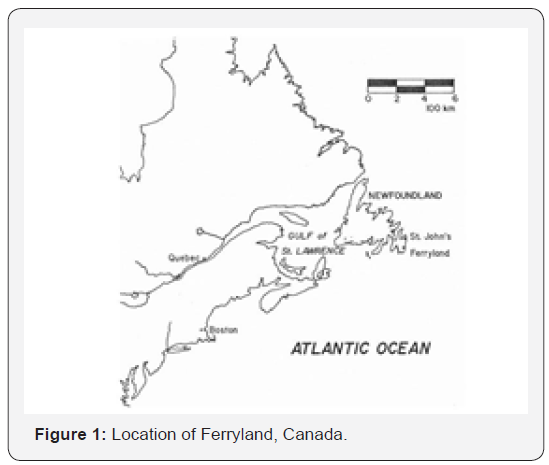
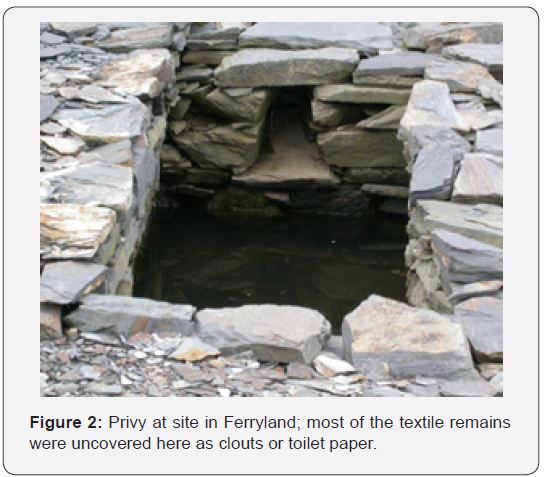

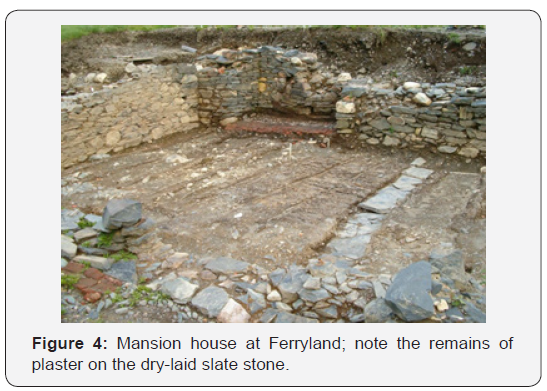
Excavations at Ferryland have yet to locate the colony’s
cemetery. During the almost 80 years of occupation during the
17th century, people at Ferryland would have died. It is likely
that Lady Kirke is buried near the colony at Ferryland [17].
Though the burial environment of the cemetery may not be
sympathetic to organic preservation, it is possible that a woman
of Lady Kirke’s status would be buried in a lead coffin, like those
of status found at St. Mary’s City buried in lead coffins, which
could afford better preservation [18]. Without this additional
comparative information our interpretation of the site cannot
help but be biased by what has been found to date. One must
therefore carefully define the features with which we interpret
the costume components of the Ferryland site. The bulk of the
textiles are from the waterfront privy. Other related materials
come from two middle-status houses, and one gentry house.
Seventeenth Century Textiles
The following cloth descriptions are based on those used by
Kerridge [19]. The cloths are presented in roughly chronological
order beginning in the 14th century and ending in the 17th
century. The earlier cloths continued to be used during in the
17th century and therefore are included. These include: says;
kersey cloth; Suffolk cloths; worsted says; worsted satins;
camlets; russells; silk damasks; jerseys; mixed stuffs; worsted
stuffs; baize; flannels; serges; linens and broad silks [20].
Says were tabby-woven while kersey, of a thicker yarn, were
twill woven and used for stockings [21]. Serges, produced in
Southampton, were also a woven with a thick yarn and fulled
to give extra warmth. Serges replaced the kersey wool but were
used for more than stockings [22]. Suffolk cloth was dyed blue
[23]. Cloth made with longer wool fibres called worsted, such
as worsted says or russells, gave a similar shiny appearance to
silk but were much cheaper [24]. Russells were therefore used
to make gowns, coats and petticoats [25]. Double russells,
manufactured in Norwich, were used to make petticoats, spring
and summer coats, scholar’s gowns, men’s vests, waistcoats and
women’s boot and shoe uppers [26]. Camlets, also produced in
Norwich using a highly twisted yarn, were used to make bodices,
breeches, drawers, cloaks, gowns, jackets and petticoats. The
russells and camlets were a finer cloth [27].
A baize was a mixture of worsted warps and carded weft
threads made of shorter hairs than worsted. Baize would have
been fulled and was popular to the 1620s. Flannels were similar
to the baize with a worsted warp and carded weft. Flannels were
used for undervests, underpants, drawers, trousers and shirts
[28]. The process of fulling wool cloth required access to water.
Exeter, which was beside a large river, had a large fulling mill
[29]. Based on descriptions of cloth by Kerridge, it is estimated
that most of the 183 tabby-woven wool samples represent
russells, camlets, says, serges and flannels. The few samples of
2/2 twill wool could be classified as kersey wools. Many of the
kersey wools were used for cloth stockings; when knit stockings
became more popular kersey wools fell out of favour [30].
Discussion
The archaeological record does not preserve all
materials
left behind by people. It would therefore be unfair to make
a judgement on the export English cloth industry of the 17th
century based on privy and midden remains from Ferryland.
An undisturbed site, such as the Ferryland privy, can provide
support for the availability of materials identified in archival
documents. The organic components of material culture are
generally less well represented in the archaeological record.
The most durable of artifacts are those made from inorganic
materials. Those artifacts represent house-building materials,
such as metal hardware and stone foundations, ceramicwares
and glass items related to food preparation and consumption as
well as metal tools. Archaeologists use these better-preserved
fragments to identify the use of space within structures, types
of food preparation, possible foodstuffs consumed, the layout
of villages, workspace usage, status and wealth. Textiles rarely
survive burial. Sometimes associated costume components will
survive, such as bale seals from bolts of cloth, pins, buckles and
buttons. This record tends to be less biased by differences in
social class than those of the written, print, or image record.
For example, when the Ferryland site was attacked by the Dutch
in 1673, the resulting destruction and burial of structures and
artifacts affected occupants regardless of their social standing. The
destructive nature of the burial environment, however, acts
differently for each material type resulting in an incomplete
archaeological record.
A thorough examination of costume from the 17th century is
fraught with problems, the greatest being the fragile nature of
the materials from which clothing items were made. The wools,
silks and linens used in the construction of breeches, gowns and
shirts rarely survive the test of time. Researchers have examined
a variety of North American archaeological sites with textiles
remains and have found that, in general, only proteinaceous
materials survive, with some instances of cellulosics preserved in
the corrosion layers of associated metals [31]. Even when found,
not all fibres can be positively identified because morphological
characteristic may not be preserved [32]. Associated materials
such as metal buttons and buckles also fall victim to the
deteriorating affects of the burial and ambient environments.
Desiccating or waterlogged anaerobic environments lead to
long-term survival of textile fibres those made of silk and wool
[33]. Unfortunately, these burial conditions are rare. The soil
conditions of the privy at Ferryland consisted of a wet, thick
soil rich in faecal matter which afforded the preservation of
both wool and silk. However, even with this wet environment
not all components of a textile necessarily survived. Dyestuffs
were likely lost to leaching. Historically, natural dyes, generally
being fugitive, were used along with a mordant. During the
17th century the common mordants were aluminum, iron, tin
or copper. Mordants would complex with the dye and fibre to
produce a more permanent dye [34]. Although mordant dyes
have a better chance of surviving, they can be masked by staining
from the organic matter in the soil [35]. It has also been noted,
but not yet published, that weld dyes can act as antioxidants and
will help preserve organic textiles [36].
The Ferryland collection contains 237 woven wool samples
and approximately 18 cloth fragments made with silk fibres. The
textile collection from Ferryland has few silk pieces. If privies
were built for use by the gentry who were the most likely to
be wearing silk, why then does the Ferryland privy contain so
few silk fabrics? Based on the good condition of most of the silk
fibres examined, with wear being attributed to use (Figures 1-5),
it seems unlikely that the burial environment would preserve
some, but not all. This must be a function not of preservation, but
rather use, preference for wool by gentry, or availability. This may
also be related to differences in climate between Newfoundland
and Europe. The cooler temperatures of Newfoundland may have
led to many wearing warmer woollen clothes, rather than silk or
linen. One possible explanation may be that the Ferryland gentry
did not use this privy exclusively or to any great degree. Perhaps
the co-operative nature of proprietorship, under Calvert, dictated
that anyone was welcome to use the privy. Though the people at
Ferryland could have added to the cesspit during its last years
of operation, there is a consistently low concentration of silk
in these strata. Supply and access to markets also might have
something to do with the scarcity of silk. Wool manufactured in
England would have been more readily available [37].

Fibre condition can tell us something about the use-wear of
the privy fragments. For example, about 40% of the silk fibres
examined exhibited cracks perpendicular to the length of the
fibre. This type of deterioration is indicative of a fibre that was
extensively bent during use indicating that it was worn a great
deal [38]. This may indicate that the other 60% of the collection
was not used extensively before being made into clouts. Some
of these samples include silk trim which was not likely used for
hygiene purposes, but nevertheless suffered little damage during
use. Some of the people of 17th -century Ferryland, with money,
did not appear to put much wear into their silk clothing prior
to discarding. Given that shipping to Ferryland was frequent,
the movement of goods such as individual costume orders was
possible and likely.
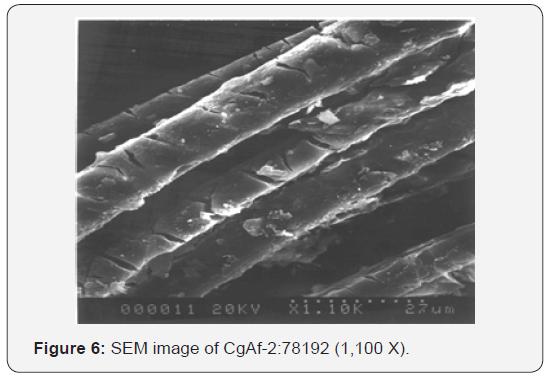
Other physical damage, such as microfractures along
the shaft of the fibre may be indicative of changes in relative
humidity in the burial environment [39]. Figure 6 shows such
an example. However, only about 10% of the assemblage exhibit
this type of physical damage. The well-sealed environment of the
privy made for a stable environment, based on its excellent state
of preservation.
One other consideration when examining condition is
the manufacturing techniques involved in textile production.
It appears that the New Draperies in the collection, when
examined under magnification, are in better condition than
the Old Draperies. This is probably a result of manufacturing
techniques. First, most of the New Draperies were dyed. If weld
were a popular dye at this time, its antioxidant properties might
aid in the preservation of silk and wool. Secondly, they represent
finer clothing and may not have been worn as often or for
laborious tasks.
The environment of the privy, though stable in terms of
relative humidity, resulted in different preservation. Textiles
found in the upper layers show evidence of insect attack (Figure
7). Wool found in the lower levels is better preserved and silk
found in the upper levels is better preserved. Rootlets were
absent throughout the privy. The faecal content of the privy
matrix may have inhibited plant growth.
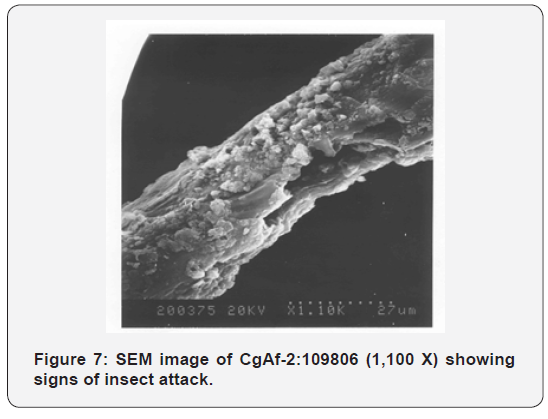
Fungus and bacteria were able to establish colonies once
the feature was opened. Both fungus and bacteria can abrade
and fracture fibres as they grow within the fibres. Some of this
type of damage can be seen on the fibres, but it is not great. One
explanation could be that the backfilling done to over-winter
the privy feature after its first year of excavation was successful
in creating an anoxic environment, lowering the survival rate
of bacteria species [40]. Archaeoentomological analysis of the
Ferryland privy indicated a population distribution of beetles as
follows: 33% in Event 116, 30% in Event 49, 30% in Event 50,
17% in Event 170 and 8% in Event 111 [41]. The percentage
differences of entomological remains could be either a factor
of population fluctuation, burial environment preservation, or
both.
In silk fibres the fibroin decay begins in the amorphous
sections. This type of degradation, of crystal structure, results
in a loss of orientation making the fibres weak and brittle. Metal
thread fragments are often preserved with the core textile, but
the substrate textile is missing because of the deteriorating
effects of burial. It is therefore difficult to predict to what object
the metal threads were attached. It is virtually impossible to
distinguish between metal threads used for costume and those
used for tapestry as they were produced alike and often in the
same shop [42].
Based on the distribution of textiles (Table 1), Event 111
appears to have offered the best environment as 44% of the
collection was found here. This could also indicate a higher rate
of consumerism and disposal during this period. Entomological
remains were lowest for Event 111 which, if preservation was
very good, might be expected to be higher. This may also indicate
that consumption was high during this period and that insect
population within the colony was low. The highest percentage
of silk was found in Event 116, with Event 111 a close second.
Entomological remains were highest for Event 116, perhaps
indicating that they were consuming silk, with a preference to
this keratin over wool. Overall, however, Events 116 and 111
contained the highest quantity of both silk and wool, probably
accounted for by environmental preservation but also by the
size of the human population, the availability of goods and the
ability to purchase.
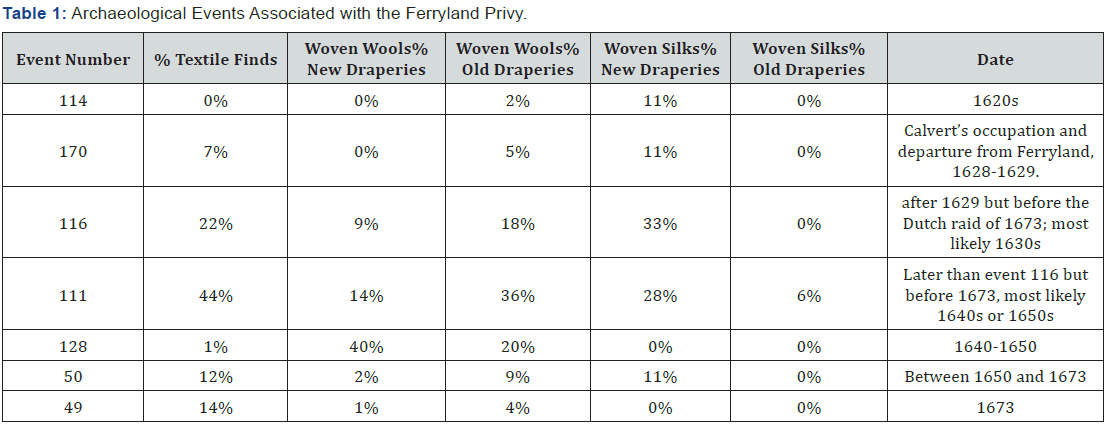

Table 2 presents the distribution of textiles found outside the
privy. Area F contains the only silk remains. This is not likely
related to preservation but is more likely a fact that this was
the result of the area of a high-status residence where silk
would have been affordable and worn. The woven wool New
Draperies were evenly distributed between Areas D and F. The
Old Draperies were concentrated in Area D which represents a
household of middling sorts.
Based on both the information reported by Kerridge,
regarding textiles from the 1600s, information garnered from
textile researchers abroad and the Ferryland archeological
textile collection, it appears that the following cloth came to
North America in the 17th century: serge; kersey; resells; camlets;
worsted says and satins; flannels; braize; and broad silk.
From the wool textile fragments found in the privy, we know
that men could have had clothing constructed from coarselywoven
cloth and finely woven twill and tabby cloth. The coarsely
woven tabby cloth likely represents a working type of breeches.
Breeches waistbands found were of a slightly finer weave, with
a 7/9 thread count, and possibly represent a pair of non-fishery
working or common breeches. There were doublets with long
tabs which were popular in the early 17th century. Fragments
which probably represent doublet wings or epaulettes were
also present and these match the doublet tabs (in terms of date)
that were also present. Fragments CgAf-2:97654a-c and CgAf-
2:106584 appear to be of a similar twill-woven fabric, possibly
from a doublet, and represent the New Draperies. The former
fragments are from a late 17th century context from the Area D
house, while the latter came from the lower levels of the privy.
These samples suggest that one bolt of cloth may have made its
way to Ferryland early in the century and was used throughout
the century. Or, more likely, this could indicate that similar types
of fabric were shipped to Ferryland throughout the century.
The silk lace and silver point, CgAf-2: 90255, are sufficiently
short to indicate that it was used for decorative purposes,
probably for a doublet [43]. These laces with points remained in
use as decoration around the waist of a doublet until about 1630
[44]. There were a few pieces of silk velvet and two fragments of
silk damask indicative of high status. Designating fragments as
components of male or female costume is difficult as either sex
could have worn these fabrics in the 17th century.
Though cellulose-based fibres were not preserved, evidence
such as a bale seal, CgAf-2:315014, representing Haarlem’s fine
linen, indicates that lengths of linen were shipped to Ferryland
presumably for the construction of undershirts for both men and
women and children. Holland linen, as it was called in England,
was widely distributed in the 17th century, based on seals found
in London, Northamptonshire, Wiltshire, Edinburgh, France,
the Netherlands, Sweden, and the Pentagoet site in Maine [45].
Examples like the British Museum seals have also been found at
St. Mary’s City dating to the mid-half of the 17th century; these
may more closely match the Ferryland seal [46]. Though the
Ferryland seal is like the British Museum example, the numbers
inscribed on the seals, which represent cloth length, are different.
The silk damask fragments appear to be French since they
matched similar samples of damask from France in the Victoria
and Albert collection and in the Royal Ontario Museum collection.
Most of the wool samples were probably manufactured in
England. Silk trim, ribbons and samples of passementerie were
possibly manufactured in London by Flemish textile workers
[47]. Metal thread production is recorded as having been carried
out in Nuremburg from the 14th century [48]. It is likely that
there were other, non-recorded, sites of metal thread production.
Was this rapid transfer of fashion to the Colonies a result
of goods being imported directly from England or were they
shipped between the North American colonies such as Boston?
Or was it because print images were imported bringing news of
change? Each likely contributed equally, given that the costume
remains seem to indicate that a relatively fashionable population
resided in 17th -century Ferryland.
The likely manufacturing centres used for the textiles
represented within the Ferryland collection include England,
Germany, France and the Netherlands. The fact that shoe
buckles show up at Ferryland within a 1660s context indicates
that costume fashion and news of its change was available
to at least some of the residents of this colony. We also know
from documents that shipments of ready-mades numbering in
the thousands were coming to Newfoundland; no doubt some
were delivered to Ferryland [49]. The ready-mades were likely
intended for the middling sorts or their servants. The silk damask
and the fancy snuff box may have been produced in Lyons,
France. The silk ribbons were likely produced in Germany or the
Netherlands. Some of the porcelain came from the Netherlands,
while most of the stoneware mugs, jugs and bottles came from
Germany [50]. We know from bale seal evidence that fabric
came to Ferryland from Exeter and London. The silk damask
samples found in the top layers of the privy, which represent the
last phase of its use in the 1670s, seem to best match a French
provenance. The tulip and leaf pattern are very similar to those
fragments of silk fabric with a French origin in the collections
of both the Victoria and Albert Museum and the Royal Ontario
Museum. That such rich silks were disposed of in the privy and not reused indicates a certain amount of wealth within the
colony, at least by those living near the privy (perhaps by those of
the Kirke household). We see evidence for the purposeful reuse
of textiles in the middling household of Area D. The elaborate
designs used in textiles and on other material culture in the 17th
century, provide evidence for the movement of consumables
and people beginning in Medieval Europe and through the early
modern period. Both periods are often viewed by the current
culture as unsophisticated, uninspired, dark and without human
comforts [51].
The material culture, however, provides evidence to refute
this notion, as illustrated by the artifacts described here. The
remnants of early works of art, revealed through conservation
provide further support [52]. Seventeenth-century Europe
underwent a great period of discovery, expansion, and
movement in terms of trade. The discovery of the Americas and
passage to the East Indies via the Cape of Good Hope changed the
movement of goods and world trade forever. A routine exchange
of commodities developed in which the Newfoundland fishery
was a significant component [53]. Contact between Europe,
America and Asia through commerce exposed Europeans to
foreign cultures through their goods (motifs were exchanged
along with raw materials) and reshaped Europe’s perception of
itself and its place in the world [54].
Dyestuffs can also tell us something about trade at this
time because they were a valuable commodity and were
documented by their place of manufacture [55]. Known dyes
were identified on 24 of the 59-fibre sample. In 15 samples
compounds indicative of red dyes (carminic acid, alizarin and
purpurin) were identified. Carminic acid was identified in four
burgundy silk samples. It was the only dye detected in two of
the silk samples (CgAf-2:127294 which was a burgundy brown
silk brocade and CgAf-2:124936 which was a burgundy silk).
Two other silk samples contained alizarin and purpurin, as well
carminic acid (CgAf-2:101147 which was a burgundy silk thread
trim and CgAf-2:124974 - burgundy brown silk brocade).
Nine wool samples and one silk sample contained alizarin
and purpurin or just one of the two dyes but no other dyes. Both
components were detected in seven samples, a brown silk satin
(CgAf-2:126469), three brown wool twills (CgAf-2:101991,
112648, 124990), a brown wool tabby (CgAf-2:101202), and
two green brown wool twills (CgAf-2:124957 and 124995).
Purpurin, but not alizarin, was detected in a green wool (CgAf-
2:109810) and a dark red brown wool (CgAf-2:127320) that also
contained gallic acid. Alizarin was detected in 109020, a brown
wool twill that contained some red fibres.
The hydroxyl flavoneluteolin was identified in seven fibre
samples: three green silks (CgAf-2:78130, 87101 and 124904);
three brown wool twills (CgAf-2:67517, 78130 and 148115);
and one yellow wool twill (CgAf-2:124994). Luteolin was
detected in two samples from artifact CgAf-2:78130, one brown
wool fragment from a jacket, and the other green silk from a
button hole.
Logwood was present in two black wool samples with a twill
weave (CgAf-2:97640 and 230445). Chromium was detected by
x-ray microanalysis in the same samples and alizarin was also
detected in CgAf-2:97640. Logwood was used as a substitute
for woad, and though fugitive, produced a purplish blue [56].
Because of its fugitive nature, this dye was banned in England
until a method for making it fast was introduced in 1605 [57].
This dye could therefore have been used to produce a black or
blue cloth [58].
The dyes identified include those common to the period.
Madder was the most common dye after woad in the 17th
century [59]. Not surprisingly therefore, madder was identified
on more samples within the Ferryland collection than any other
dye compound. Cochineal, an expensive dye, was identified only
on the silk fragments. Madder and weld were identified on both
wool and silk. Weld, or dyer’s weed, was one of the major sources
of yellow [60]. Logwood dye was identified on wool. Samples
which tested positive for tannin included 15 wool and 11 silk
fragments. Samples which tested negative for dyestuffs included
nine wool samples. Un-dyed wool was not uncommon at this
time and it is therefore unsurprising to find some wool samples
without dyestuffs, although this may represent leaching by the
soil matrix. Though tests for blue dyes were performed none
were found, apart from the 18th century Prussian blue.
An overall view of the textiles based on the results of dye
analysis indicates that textiles were coloured either red or
yellow. It is difficult to speculate as to why there was a preference
for red and yellow at Ferryland. Cunnington cites a reference
to the wearing of blue at this time, to be used for the dress of
apprentices and servants [61]. If this is in fact true, it might
suggest that the Ferryland privy was used only by gentry. Or it
could simply be that supply ships did not go to areas where bluedyed
textiles were manufactured. Kerridge notes that Suffolk
cloths were a true blue in the wool. Here woad and indigo dyes
were used to create a range of shades [62]. Neither cloth bale
seals nor other material culture excavated at Ferryland, to date,
indicate a trade link with Suffolk. Woad was not grown in large
quantities in England until the 1560s [63]. Though both madder
and weld were grown domestically, most of the madder was
imported from Flanders and Zealand [64]. Other dyestuffs were
imported, gall-nuts (used to fix logwood) from Venice, cochineal
from Central and South America, and logwood from the West and
East Indies, Central and South America and Virginia [65].
The high percentage of tannin identified along with the two
logwood dyes might allow one to speculate that these represent a
black or blue dye. Aluminium and iron elements identified could
represent mordants used to make the dye fast [66]. The absence
of woad or indigo, within the collection may be explained by the
fact that logwood was used to produce blue.
Extant costume provides further evidence of what was
available for English consumers in the 1600s. Based on this
evidence, and the fragments found at Ferryland, one may
think that costume was used as an identifier of status in North America to the same extent as it was in England. The question
as to whether or not costume was used as an identifier of
social change in the colonies is much more difficult to address
because of limited accounts of society there. Excavations at sites
comparable to Ferryland, such as Jamestown and St. Mary’s
City, are not yet complete; archaeologists and anthropologists
continue to investigate and interpret social changes through
the analysis of artifactual and structural remains. The changes
that occurred at Ferryland are as follows: documentary records
indicate that Sir George Calvert initially ran the early colony as
a co-operative venture from 1621 to 1634; but when Sir David
Kirke and his family arrived in the late 1630s, the colony’s cooperative
nature changed to an entrepreneurial one where taxes
were levied.
The price of cod and its abundance fluctuated throughout
the 1600s and the colony was attacked by the Dutch in 1673
but continued until the French attack of 1696 [67]. It seems
that from about 1640 to 1670, the colony at Ferryland, under a
capitalist vision, experienced a significant gain in wealth [68].
Potentially, the colonists had greater buying power during this
time. Boats were coming and going more frequently which made
it possible for costume-related items to be readily available at
Ferryland. Based on links between Newfoundland and English
ports, drawn by Pope, an estimated 86 boat crews from Jersey,
London, Southampton, Torbay, Dartmouth and Plymouth may
have brought goods to Ferryland in 1675 [69]. Therefore, the
same social changes that came with the Reformation in England,
and the associated changes in costume such as rich textiles,
ribbons, expensive dyestuffs, could have been seen at Ferryland.
Textile remains support this interpretation.
From inventories and cargo manifests, one sees that there
was a consistently high demand for alcohol and tobacco among
the colonists at Ferryland; likewise, there was demand for bolts
of woollen cloth [70]. What did the consumption of luxuries
such as wine and tobacco say about the men and women who
lived and worked in 17th -century Ferryland? It could mean that
if they could afford luxury grocery items to be consumed in
Ferryland, then they likely had and consumed luxury costume
and household goods as well.
Weatherill argues that the material culture associated
with domestic life was closely linked to the practical everyday
lives of the household and it is within this everyday existence
that one will find the meaning of consumption [71]. Most
archaeologists would agree that the objects recovered from a
house structure reflect the main activities of that household.
Therefore, an understanding of consumption patterns could be
gained through the examination of excavated objects. One could
assume that costume and household textiles would offer similar
insights. In considering patterns of consumption for Ferryland
in the 17th century, one must be cautious however, because the
fragments analysed in this dissertation are discarded materials.
The time lapse between use and discard particularly for the
specimens from the privy could change the interpretation of
past consumption patterns.
There would have been goods consumed that did not
wear-out and were therefore not disposed of. Both the privy
contents and those from middens do provide us with hints
of the goods that came to Ferryland, either with the colonists
themselves or on ships as trade goods. Costume can be viewed
as an object of necessity in that it serves to protect the body
from its surrounding environment. Unlike a bowl for consuming
food which may or may not be absolutely necessary, clothing
became not only a consumable with practical meaning, but also
one which could be used to identify an individual. Textiles as a
commodity are personal products. For centuries, they have been
used to drape the body, wrap the wearer, seductively or modestly,
for public viewing; textiles likewise can be used as swaddling
clothes at birth and a shroud at death [72]. Because fabrics are
woven, flat and generally absorbent, they have also served as
a substrate for applying decoration via embroidery and colour
via dye compounds. In this way, an applied decoration or colour
could become a cultural signifier or emblem of status. One must,
however, first determine whose culture is being interpreted. For
example, the motifs on 16th-century Spanish silks, which were a
blend of Chinese and Islamic symbols, influenced silk production
in 17th-century Europe and England [73]. During the 17th
century, the French, dominated the silk industry, but the English
silks became popular at the end of the century. Examination of
extant textile reveals the incorporation of foreign motifs and
designs into European culture [74]. Manufacturers, wanting to
please their clients, also blended traditional textile designs and
motifs to suit the tastes of European customers [75].

By the end of the 17th century, because of demand, much of
Asia’s goods for export were mass-produced; a similar trend
occurred in Europe. This included pottery, fabric and gowns.
Thus, because of the desire to mass-produce goods, the motifs
on silks became blended and adapted to fit with this need and
ideology of rapid manufacture. Elements which might have
been distinct to the Tang dynasty or of Islamic origin were
stylized and attributed to the French or Spanish cultures. For example, within the ceramic remains at Ferryland, we see the
incorporation of Islamic design on Portuguese ceramics (Figure
8). Other imported goods, such as Chinese porcelain, are also
visible evidence of different cultures. Porcelain represented the
high status of the owner of such items. One piece of high-quality
porcelain, CgAf-2:377874, probably a tea bowl with base and
rim section, was excavated from an early 17th -century context
in the Kirke house.
By the late 17th century, England’s economy had changed yet
again with the wealth of the country being shared among those
of the middling sort. This ultimately meant that luxury goods
found a wider consumer group still further down the social
ladder [76].
For example, a hair comb, CgAf-2:508922, found in the area
of the Kirke house could have been owned by one of the lower
sort working or doing business for the Kirke’s (Figure 9). By the
1600s goods from different parts of the globe were being traded
within Western Europe. This practise became fairly standard
by the end of the century. At this time, the less expensive exotic
goods were available to the general population.
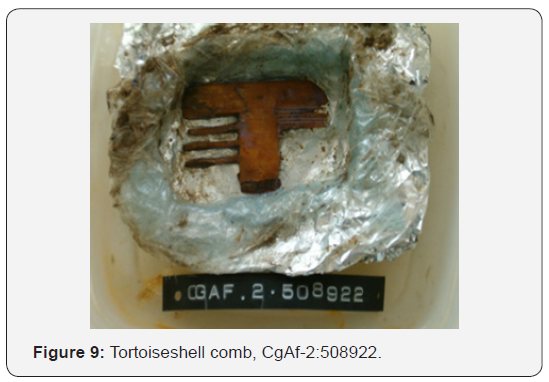
Exotic goods such as tobacco, tea, chocolate and coffee also
were consumed by everyone. These commodities, however,
were consumables, though for some, additional props would
be added to the ritual of consumption, for example tea drinking
rituals complete with table settings or the tobacco pipe for
smoking. Therefore, consumable commodities generally did
not have a lasting life. They were visible in the course of their
consumption but then they were gone. For the consumption of
tobacco, coffee and tea, an addiction could develop, and a routine
of consumption created. In this example the consumption of the
commodity would be visible but not always constant [77]. The
large number of tobacco pipe fragments, excavated at Ferryland
(Table 3) provides evidence of extensive consumption of tobacco,
a luxury grocery at Ferryland. Textiles by contrast, would be
a more visible commodity either worn on the body or as part
of the domestic space as curtains, bedding and pillows where
decoration and colour potentially would have a greater meaning.

16,000 fragments were recovered from the “Kirke House”.
The 17th century was a period of increased consumption
of commodities by the middling sorts and to a lesser degree
by labourers. As noted by Wetherill, in her study of window
curtains from 1675-1725, consumption patterns are not
predictable because factors, such as availability and differences
in sensibilities, are difficult to determine. In the case of window
curtains, a luxury good, the highest percentage of curtains were
found among the middling sort followed by the gentry [78].
The material culture, excavated from the middling domestic
structures, such as Areas B and D, support this observation made
on the basis of probate documents [79]. Documentary evidence
shows that the population at large was aware of the link between
providing evidence for ones social life through consumer goods
[80].
In 17th-century England, the household was still, in most
cases, the site of both production and consumption [81].
Changes in demand within the textile industry resulted in
changes in production. The increased popularity of the New
Draperies which required finer worsted wools, dyes and broader
looms took the industry out of the home and into a central, often
urban, area [82]. This change has afforded better records for
researchers to examine. Therefore, a better understanding
of what was available to purchase at this time was garnered
through the factory records. Understanding what was available
to those in North America is much more complicated. Firstly,
records specific to consumption of goods in North America seem
limited. Probate inventories did not always survive as they were
initially sent back to London for storage. For most of the 1600s
consumerism in North America was dependant on the rate
of trade between the America’s eastern seaboard and Europe.
References to clothing were not always recorded [83].
We may not know exactly what the nature of textile
consumption was for Ferryland, because of the lack of
preservation of textile remains and a paucity of historic
documents, but because it is clear that textiles were not produced
in Ferryland and therefore had to arrive by boat, we can look
for other evidence of foreign textile consumables. These foreign
consumables were shipped on vessels which most likely held
bolts of cloth and ready-made goods as well. For our purposes
the presence of the New Groceries, tobacco, sugar and caffeine
drinks, can be used to indicate the availability of consumables at
Ferryland and wealth of the colony.
Within the archaeological record, the tobacco clay pipe is the
most ubiquitous of all items used to consume the New Groceries.
Tea bowls or mugs can be used to indicate the presence of
tea or coffee, but these could be used for other fluids at times
when the intended drink was unavailable. We know from both documentary evidence and archaeological examination that
neither tobacco, sugar cane nor cocoa beans were grown in
Ferryland; these plants simply could not grow in Newfoundland’s
sub-artic climate [84]. Because of this, the presence of tobacco
pipe fragments is directly related to the importation of tobacco
to the colony. Therefore, an examination of clay pipe fragments
from the Ferryland site, used as an indicator of the availability
of tobacco, can likewise also demonstrate that ships coming to
the colony brought goods for trade and not just to pick up dried
cod to return to European ports for sale. An examination of clay
pipe bowls is therefore used here to give an overall idea of the
extent to which the relatively new habit of tobacco smoking
was adopted by the people of Ferryland. The clay pipe was in
use from the early 1600s to the 20th century. As a dating tool,
however, clay pipes changed stylistically and often had a datable
maker’s mark applied, which allows it to be used to date strata
in the archaeological record [85]. It is not within the scope of
this thesis to examine all pipe bowls to separate early ones from
later ones. As shown in Table 3 this would require a significant
amount of work, some of which has been done by past MA
students at Memorial University [86]. For this research, the
presence of the early pipe bowls at Ferryland is evidence of ships
bringing tobacco and, potentially, other goods such as textiles.
All of the material remains found at Ferryland were
manufactured off the Island. The artifactual remains,
approximately 1.5 million to date, are too numerous and
varied to represent objects merely brought to Ferryland by the
colonists. Though some of the material found was no doubt
brought by families, most represent objects of trade. There were
three means by which trade goods reached Ferryland, the sack
ships (20-80ton vessels), the fishing ships (50-130ton vessels),
or by the practice of portage [87]. The sack ships which sailed
to Newfoundland in the summer to buy fish from planters or
buy-boat fishermen (inshore fishermen) were likely the source
of most foreign goods [88]. Portage was the right of a sailor to
carry goods to a particular location for the purpose of re-sale.
This was allowed in lieu of wages [89]. Smaller items such as
textiles and costume-related material were likely transported to
Ferryland by this practice.
While viewing textiles at the Victoria and Albert museum, a
selection of wool textile fragments from the Museum of London
were examined. These textiles, representing fabric fragments
discarded in the Thames, were similar in weave to some from
Ferryland. These fragments from the Thames were broadly
dated to the 16th and 17th century and 70% of them were New
Draperies. This confirms that New Draperies were readily
available in London currently.
The madder identified in the Ferryland samples also tested
positive for alizarin [90]. This is considered typical for wild
madder Rubia Peregrina which contains 11% alizarin. Another
discovery in the Ferryland collection, is that madder and
cochineal were mixed to form the colour in many of the silks
[91]. Samples which tested positive for tannin included 15
wool and 11 silk fragments. Samples which tested negative for
dyestuffs included nine wool samples.
What do the small finds tell us about life in Ferryland?
Researchers believe that shoe buckles began to be used during
the last quarter of the 17th century [92]. Within the Ferryland
collection shoe buckles are present at about the same time.
Approximately 30 two-piece buckles, no two alike, which may
have served as shoe buckles, were found at Ferryland contexts
from the second half of the 17th century. Three of these were
made of silver, the others of a copper alloy. For a colony with
a population of some 150 people, this could mean that 20% of
the population was wearing buckled shoes by the second half
of the century [93]. Only three two-piece buckles were found at
St. Mary’s City and no buckles of this type were found at Cupids.
This suggests that shoe buckles were more available to Ferryland
and that colonists had sufficient money to buy them.
Coins likewise contain information about costume [94].
One Ferryland coin depicts a falling linen collar. This coin, CgAf-
2:298218, is identified as French and dates to the 1630s [95].
Where exact dates are lacking, items of material culture which
incorporate costume from extant or archaeological examples
can be used to confirm dates. For example, a similar collar at the
Gallery of English Costume, Manchester, M7755, has been dated
to the 1620s-1630s which coincides with the date assigned to
the coin. Likewise, tin-glazed ceramics of the 17th century also
incorporate figures dressed in costume of the period. Where
archaeological samples may lack an exact date, the costume
depicted can be used to provide an estimated date. Like printed
images, however, one must assume that the costume depicted is
contemporaneous with the object’s date of manufacture.
Self-importance based on the public image one created was
significant during the 17th century. The nobility, gentry and
middling sorts strove to be up-to-date with the latest fashions as
observed in documentary evidence, paintings, prints and extant
costume. The archaeological remains, which usually provide an
accurate reference for dating, also support this observation.
The growth of venues for public gatherings such as the coffee
houses and taverns also contributed to the growth of this display
culture. People were out in public and wanted to be seen at their
best. No longer was the home the only showcase. While in public
view one’s attire would provide a visual image of their place
in society. The growth of print culture also drew people into
public venues. The number of pamphlets produced in England
grew from 22 in 1640 to 1,966 in 1642 [96]. Coffee houses were
popular and available to all. Here broadsheets could be read and,
in some cases, read to an audience. Here was a place to acquire
knowledge of the current events.
Some of the questions answered here touch on the
traditional themes of historical costume studies: the textiles’
poor preservation; incomplete archival records, such as the undocumented exchange of costume goods; and an incomplete
depiction of life in the contemporaneous visual record. Extant
documentary records from the 17th century should be further
explored to reveal additional information regarding costume.
Further aspects of the adaptation of costume should also be
examined. More work could be conducted to identify evidence
of dye plants being grown in 17th century Ferryland. In addition,
evidence for sheep herding and weaving could be examined.
On-site excavations at Ferryland and continued analysis may
uncover some of this information. For example, does the quality
of textile remains increase when the Mansion house is found?
If the cemetery associated with the site is uncovered, and if
its contents are well preserved, one might gain information
regarding the quality of complete costumes. With further
excavation, the distribution of people in their living quarters
may be revealed. Did the colony always have a resident tailor?
Was there more than one at any time during the 1600s? Further
excavation could reveal a storehouse of cloth and other supplies
used by a tailor. All of these questions could lead to a greater
understanding of the independence and co-dependence of
Ferryland’s 17th-century population in relation to England and
Europe in reference to costume.
Seventeenth-century England could be characterized as
being a time of internal turmoil [97]. It was also a period of
colonization of foreign lands and an increase in technological
advancements. For example, the facets cut on a crystal drop,
(Figure 10) CgAf-2:402107, would not have been possible in
the previous century. Perhaps both the conflict within England
and a desire by the nobles and gentry sorts to explore outside of
England lead this nation to succeed in the transplanting of people
to places such as Ferryland, Newfoundland. The Calverts and
Kirkes left England for a more peaceful existence in Ferryland.
Outside of the reaches of parliament and the monarch, this
colony flourished, possibly because it was less affected by the
politics of the time.
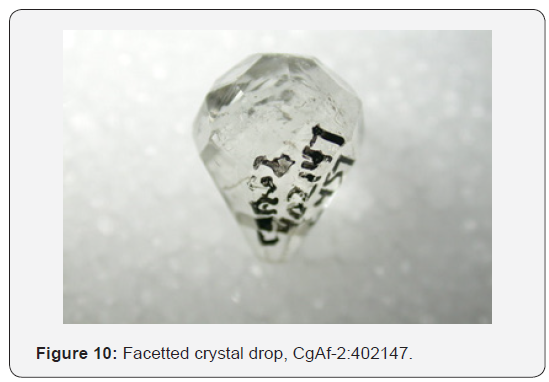
In terms of costume for the Ferryland site, we are questioning
whether the growth in fashion in post-Medieval European
populations was carried over to those colonizing North America.
Could regional differences be identified, in this case, between
England and the Colony of Avalon? Did changes in fashion and
culture in England also occur in Ferryland? If so, was this at the
same rate or was there a time lag because of distance form the
cultural hub of London? Do we see signs of adaptation in terms
of costume this early in the historic record?
The small finds, which constitute the associated costume
components and the fragile organic textiles often don’t survive
because of the aggressive nature of the burial environment;
hence the cold, moist environment of Eastern Canada aid in the
preservation of some significant textile finds.
The degree of artifact preservation does make predictions
of culture difficult. The non-ferrous metals used to produce
the buttons, buckles and other costume components are
well preserved at Ferryland. One can therefore draw some
conclusions about the status and general standard of living based
on what has been preserved. One must, however, be cautious and
mindful that the colonists relied on what they brought with them
and what was available on the sack ships and fishing ships that
visited Ferryland’s harbour. To date, the bulk of the textiles, have
come from a privy feature which provided an almost anaerobic
moist environment sympathetic to their preservation. These
fragments, however, represent re-use; although this serves as
evidence of the types of fabrics used at Ferryland, their dates
are poorly defined. We know that the privy was in use from the
1620s to the 1670s and that it contained a high proportion of
the New Draperies. During the 17th century privies were usually
used only by the gentry sorts. The group of textiles found in
the Ferryland privy generally support this. The Nanny privy in
Boston also contained fragments of luxury textiles; this privy
was associated with a high-status household of the late 17th
century. Though the dates of each privy do not correspond, for
comparative purposes textile and costume pieces made their
way to North America throughout the 17th century. It appears
that this is the case for English settlements early in the century.
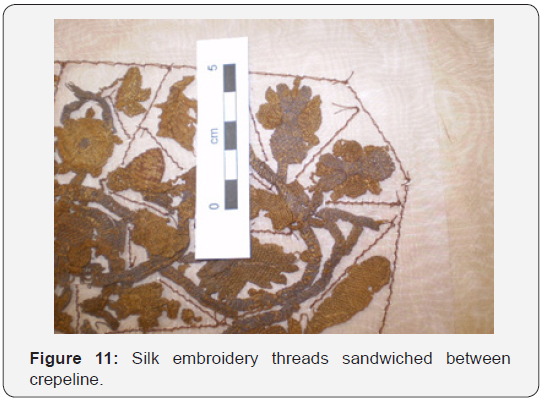
The contents of the privy are the most significant repository
for textiles. The textiles are divided between tailor’s scraps made mostly of silk and square fragments of wool used for
hygiene purposes. The former represents the gentry and the
contemporaneous creations of a tailor. The latter represents
reuse of worn or out-of-fashion clothing items. One might
also divide the contents by their quality and cost with silks
representing greater luxury than the wool. Overall, however,
given the large quantity of the New Draperies, the dyestuffs
used, and weave structures, it appears that the colony was not
poor, but instead offered a high standard of living for all. Another
collection of textile fragments was a lump of embroidered
threads on a silk substrate. When unfolded, cleaned with
water and freeze dried this lump seems to resemble a women’s
embroidered jacket dating to 1620 on exhibit at the Museum of
Costume in Bath, England. Figures 11-14 show some of these
embroidered threads.

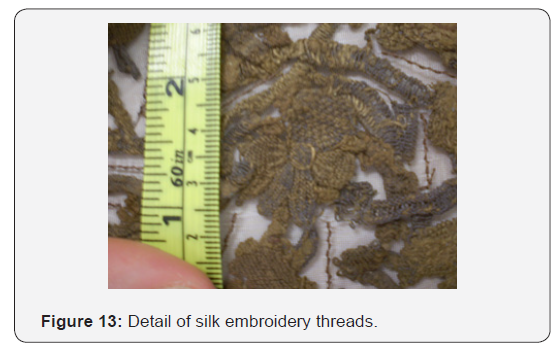

In a broad sense, historians and archaeologists have
examined the colonisation of the New World in the early modern
period to document adaptations to a new environment, the
transfer of Old World ideas and technology and the invention of
new solutions. This thesis further contributes to this research.
Differences in the Ferryland privy with its high wool content and
the Boston privy where silk was dominant may provide evidence
of adaptation by gentry to the cooler climate of Ferryland. The
material culture found at Ferryland, in terms of both costume
and non-costume related goods, indicates that there was a rapid
transfer of commodities from Europe. This is not surprising
given the volume of shipping essential to the region’s cod fishery.
The fact that boats came to Ferryland did not necessarily mean
they would bring commodities for consumption. This would
have occurred only if there was sufficient wealth to pay for such
goods. The overall quality of material culture found at Ferryland
supports the notion that there was indeed essential wealth to
bring in such goods. Did those living in 17th century Ferryland
attempt to emulate their English domestic environment? Overall
building construction, though not as grand as that found in
England, appears to be based on English styles [98]. The rise
of the middling sort is of importance here as the archaeological
evidence at Ferryland clearly indicates the presence of middling
and gentle folk. The middling sort comprised a newly-defined
social group in the late-seventeenth century [99].
Though the items of jewellery found at Ferryland are
relatively few, the range in quality and value from middling to
gentry, which fits nicely with the range in status of those at the
colony. Moreover, most of the items of jewellery available in the
17th century is represented at Ferryland.
Conclusion
An examination of textile, jewellery, buttons and buckles
along with the ceramic assemblage from Ferryland clearly
indicates that many colonists had wealth and brought some
fancy items with them. This contrasts with the colony’s gentry
buildings which were in general smaller and less extravagant
than homes of the gentry in England [100-136]. At a time where
visual presentation was important, this is one aspect of the
Ferryland colony that fits poorly with activities back in England.
Captain Wynne and other colony managers had a vast quantity
of building materials available to them in the surrounding
area. Perhaps a knowledge of piracy in the area influenced the
building style to such a degree that the colony was purposely
built as a middling settlement and therefore not worth the effort
of attack. Costume could be displayed or hidden on demand. It
appears that the people of 17th -century Ferryland used personal
belongings and costume to identify their status [137-180].
What is certain at this point is that William Sharpus, a tailor,
arrived in Ferryland in 1622 to practice his trade. From excavated
bale seals, we know that cloth was sent to and unloaded at
Ferryland. Given the presence of a tailor, one would expect to
find some archaeological remains to support this occupation [181-210]. Numerous thimbles, pins, scissors and scraps of
cloth have been found, all of which support the presence of this
activity. This may be one indication of self reliance on the part of
this community of some one hundred and fifty souls.
The print culture studied here provides further evidence
and support for the material culture found at Ferryland being
from the 17th century. Each dated print contains a fragment of
costume detail from the past, such as buttons, hats or shoes,
which have been found in the 17th century context at Ferryland
[211-238]. Though there is little more that can be said here, from
an archaeological point of view this conclusion is significant.
Because the burial environment is not a complete picture
of the past, many mis-interpretations can be made. The 17th
century print culture represents a resource yet to be utilized by
archaeologists.


Through the one hundred years of textile finds from
Ferryland, Newfoundland, there were many changes in the
textiles and related artifacts from the course Old Draperies to the
finer and softer New Draperies and from ties to covered wooden
buttons to cast metal buttons. The footwear gained height with
heels, shape and colour with dyes. The hats went through many
stylistic changes, but also material ones from knitted woollen
caps to tall shaped beaver hats. A man’s costume developed into
one which included breeches, vest and coat – the suit which is
still worn today, though appearing somewhat differently in style.
The 17th century was a time of many political, environmental
and economic changes. The English colonized new lands and
continued to grow as a world empire. How people perceived
themselves and how they dressed themselves to be perceived by
others could not help but change in such a climate. The century to
follow would bring even more elaborate costume as the country
continued to grow. It was, however, the great expansion of
Europe through colonization, (Figure 15-17) in the 17th century,
of which Ferryland, Newfoundland was an important part, that
set the path for the 18th century.
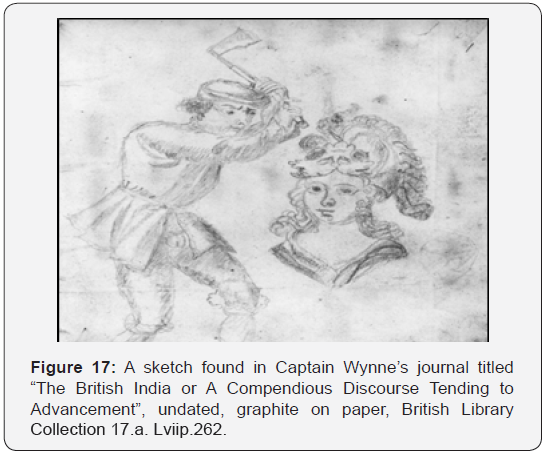




Comments
Post a Comment